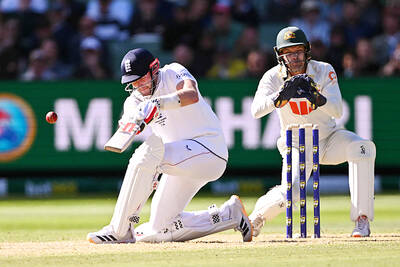Twenty-five years after her collision with Zola Budd left her sprawling on the Los Angeles Olympics track, Mary Slaney still wonders if the race that came to define her could have had a different outcome.
“All I know is that I ran the race unlike any other time I raced,” the US’ greatest middle-distance runner told reporters on a recent sunny morning.
Typically a front-runner, Slaney — then Mary Decker — said she followed her coach’s advice when she let others lead a portion of the 3,000m final many believed would bring her the ultimate prize of an Olympic gold medal.
“And that’s what I did,” said the 50-year-old Slaney, reflecting on the moments before she became entangled with the barefoot-running Budd and tumbled into the infield, injured, while the race continued without her.
Her coach, Dick Brown, told a news conference the next day that he and Decker, who was already world champion, had planned to let the South African-born, British-vested Budd lead, if she wanted, until the final lap. Their concern, he said, was not Budd, but eventual winner Maricica Puica of Romania.
“I am thinking the Olympics are so important, maybe I should listen to the coach,” said Slaney, who paced early portions of the race.
Although she no longer replays the Aug. 10 race in her head, she admitted: “If I had to go back and say: ‘Oh, are there any regrets?’ ... Well, the big regret is that I didn’t run the way I normally would have run.”
At the time, Slaney blamed Budd’s inexperience for the collision, even though Olympic officials cleared the teenager of fault.
Slaney, who had undergone several operations because of problems with her legs, had been denied the chance to compete in the 1980 Moscow Olympics because of the US-led boycott.
Heavily criticized in 1984 for her reaction towards Budd, Slaney still feels the pain of what happened.
“How is someone in their early 20s that’s been training and trying to get to the Olympics since they were 10, and it happens to be on US soil ...” she began before trailing off with: “And oh, my God.”
She said, though, that her reaction might have been different if she had been older at the time.
“You can’t change it,” said Slaney, who turns 51 on Aug. 4. “You don’t know if it would be any different if it happened now ... [but] I think as you get older, you are able to control things a little more with yourself.”
She and Budd participated in several events over the years that followed, but “there is really not a relationship,” the American said.
“It’s not like I knew her before or really had the opportunity to know her after. It’s just history,” she said. “It’s a part of the sport, part of what happened.”
The two exchanged letters for a year.
“We both wished people would just leave it alone and let us get on with running,” Slaney said. “But that was not going to happen.”
After all, as Slaney asked rhetorically: “How many Americans do you think remember the American that should have won that was lying on the track?”
The moment fixed Slaney’s image in the eyes of the US public. It also inspired her.
“In 1985 I just wanted every single time that I stepped on the track to prove that I was the best,” Slaney said.
She had done so at the 1983 world championships, boldly winning both the women’s 1,500m and 3,000m, and in 1985 she conquered the world again.
“That was a satisfying feeling to run the entire season being undefeated, run against everybody from the Olympics, essentially run all my fastest times except the 1,500 ... break the world record in the mile and win the overall grand prix,” she said.
She never won an Olympic medal, though.
Eighth in the 1,500m and 10th in the 3,000m at the 1988 Seoul Olympics, Slaney missed making the 1992 US team by one spot in the 1,500m and failed to advance to the 5,000m finals at the 1996 Atlanta Games.
Even more upsetting was a controversial doping test at the 1996 US Olympic trials that showed her ratio of testosterone to epitestosterone was higher than international rules allowed.
Slaney and her lawyers contended the test was unreliable for women taking birth control pills but the sport’s international governing body, now the International Association of Athletics Federations (IAAF), temporarily suspended her in June 1997. US officials reinstated her after a hearing but an IAAF arbitration panel ruled in 1999 that she had committed a doping offense.
“It was an attack on my character, an attack on my entire running career,” Slaney said. “I just felt like someone ripped my heart out.”
Along with 17 official and unofficial world records, Slaney once held the American record for every distance from 800m to 10,000m. Five US records are still hers.
“I helped with the progression of female running, female sports in this country, which gives me a large amount of satisfaction,” she said. “But at the same time, I felt there was so much more ... with all the injuries, all the surgeries and everything else. I feel like I would have liked more chances.”

STILL IN THE HUNT: Rasmus Hojlund took his goal tally for SSC Napoli to nine as the champions cruised to a win at US Cremonese and stayed two points behind the leaders Inter on Sunday stayed at the Serie A summit after beating Atalanta BC 1-0 to maintain their slender lead over local rivals AC Milan. Lautaro Martinez netted the only goal of the game in Bergamo for Inter, who lead Milan, 3-0 winners against Hellas Verona thanks to Christoper Nkunku’s first Serie A goals, by a single point at the top of the division. The Argentina striker has scored in four consecutive league matches to end what has been a tricky year in positive style. “I ended last season in a lot of pain... I kept going during the Club World Cup and international

Hosts Morocco on Friday were held to a 1-1 draw by Mali at the Africa Cup of Nations, ending their world record run of wins and leaving them still to make sure of progress to the next stage. Midfielder Brahim Diaz tucked away a penalty in stoppage-time at the end of the first half, but Mali equalized from the spot midway through the second half through Lassine Sinayoko. Both penalties were awarded after video reviews in a tempestuous clash at the end of a busy day of action at the tournament. Morocco were atop the Group A standings with four points, while Zambia,

An astounding 20 wickets fell on a frantic first day of the fourth Ashes Test yesterday, with Australia all out for 152 before storming back to dismiss England for 110 and leave the clash on a knife-edge. England skipper Ben Stokes won a key toss on a green track and his quicks feasted after sending in the hosts under overcast skies in front of 94,199 fans at the Melbourne Cricket Ground. It was the biggest cricket crowd ever at the cavernous arena, exceeding the 93,013 who watched the 2015 World Cup final, and they witnessed the home side collapse with Josh Tongue

Algeria on Sunday became the third country after Egypt and Nigeria to qualify for the knockout stage of the Africa Cup of Nations by edging Burkina Faso 1-0 in Rabat through a Riyad Mahrez penalty. Defending champions Ivory Coast failed to join the trio after drawing 1-1 with Cameroon in a lively showdown in Marrakesh. Elsewhere, Mozambique ended a 39-match wait for a first victory by beating Gabon 3-2, while Sudan got back into contention for a last-16 slot by beating Equatorial Guinea 1-0 in Casablanca. Captain Mahrez converted from the penalty spot midway through the first half and Algeria then held on